Wong Din Haan: A Pioneer Educator
Wong Din Haan, who founded a girls’ school in Singapore, was also a champion for women’s rights. Patricia Lim tells us more.
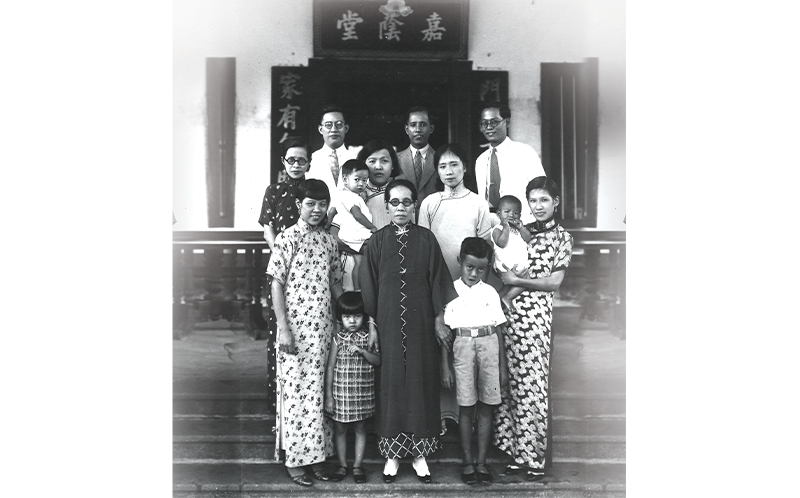
“When[ever] the [Wah Kiew Nui Hok] school holds a general meeting, people will see a middle-aged lady sitting at a corner, listening to the speaker patiently. No matter how long the meeting goes on [for], she maintains herself in an upright posture. However, as she had never spoken a word during meetings, someone might think she is a less enthusiastic person, or the one with inadequate words. But actually, this quiet woman is exactly the most passionate person of all.”1
This “quiet woman” is none other than my grandfather’s sister, whom I addressed as Saam Koo Por, which means third paternal grandaunt in Cantonese. She founded a school for girls in the early 20th century.
My family is Cantonese. Saam Koo Por’s name was Wong Mei Ho (黄美好), but as a Hokkien clerk had transcribed it in the Hokkien fashion so her name became Wong Bee Ho in official documents. At some point after her marriage, she returned with her four children to live in Singapore with her father Wong Ah Fook (黃亞福),2 who was my great-grandfather.
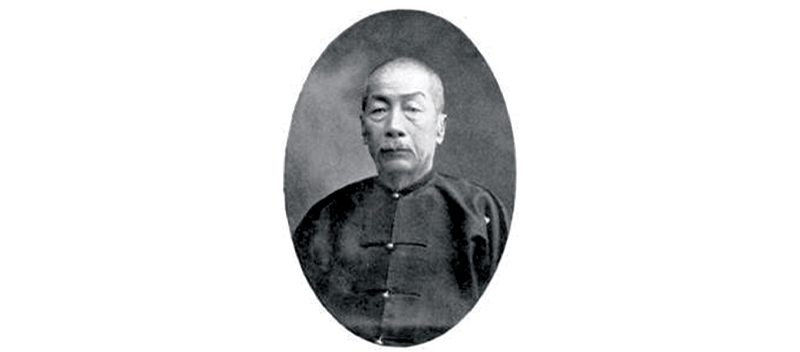
It was much later that I discovered she was known by another name. I had attended a lecture by Professor Zheng Liang Shu (郑良树; Tay Liang Soo) of Southern University College, Johor, where he spoke about the pioneer educator Wong Din Haan (黄典娴; Huang Dian Xian). The second daughter of Wong Ah Fook, my grandaunt had founded a school for girls in Singapore.3
I was confused because no one in the family seemed to know about the existence of this girls’ school until I asked one of my uncles, Pang Heng Hung. He confirmed that she was indeed the founder of a school known as Wah Kiew Nui Hok (华侨女校), which was located on New Bridge Road. His mother was Wong Bee Soo, Wong Din Haan’s younger sister, who had been a teacher in the school.
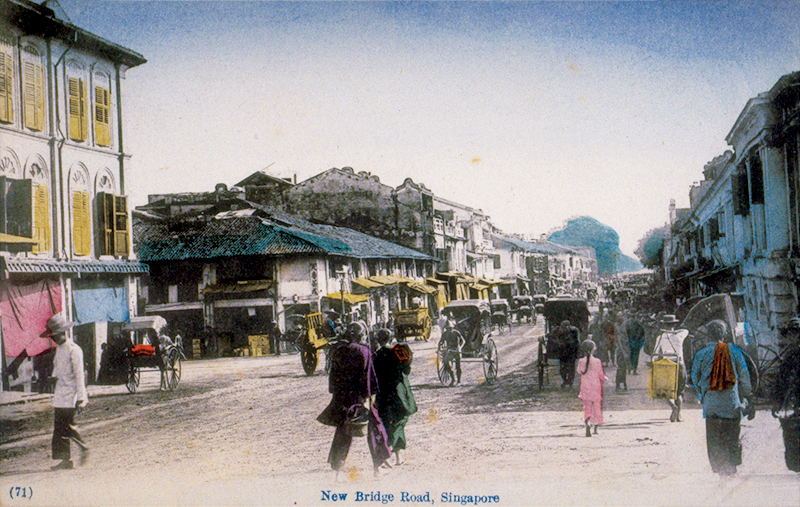
Pioneer in Female Education
Founded in 1905, the school can be linked to the events in China following the aftermath of the Boxer Rebellion that lasted from 1899 to 1901.4 The Boxer Protocol signed on 7 September 1901 ended hostilities and those involved were executed. Following this, Empress Dowager Cixi reluctantly gave way to pressure for reforms and an extensive reform programme simply referred to as New Policies – a series of cultural, economic, educational, military, social and political reforms – was launched in late 1901.
Reforms to the education system in China also had an impact on Chinese education in Singapore. The Chinese imperial examinations (科举) to select candidates for the state bureaucracy, which had been the pinnacle of the education system in China for centuries, was abolished in 1905. The entire education system was overhauled and an Education Bureau was established to take charge of the modernisation and administration of national education leading to a university degree. In his book, The Rise of Modern China, Immanuel Hsü noted that provincial academies were transformed into colleges, prefectural schools into middle schools, and district schools into elementary schools.5 These reforms marked the beginning of the modern Chinese education system.
Although born in Singapore, my grandfather Wong Siew Nam (黄兆楠), who was better known in literary circles by his alternate name Wong Ging Tong (黄景棠), was then living in Guangzhou. Like other intellectuals of his time, he would have been caught up in the fervour for reform although we have no evidence of his role, if any, in the reform movement. However, he was a friend of the leading thinkers and political activists of the time, Kang Youwei (康有为) and Liang Qichao (梁启超), both of whom were also Cantonese. As a person who had sat for and obtained a degree in the last imperial examinations held between 1909 and 1912, my grandfather greeted the reforms in education with enthusiasm and could not resist the challenge of establishing a new category of school with a new syllabus and new teaching methods.
Together with my grandmother, Mah Lai Wan (马励芸), grandfather founded a girls’ school named Kuan Wai Nui Hok (坤维女学) in Guangzhou in 1905 with grandmother as headmistress. She held the post for some 20 years and after the war, the school was managed by my aunt Tang Yung Hing (邓蓉馨) until 1949. It still continues today as the 29 Middle School.
Grandfather must have communicated his enthusiasm to his father because Wong Ah Fook was among the group of Cantonese businessmen in Singapore who founded Yeung Ching Hok Hau (养正学校) for boys in 1905. It is best remembered by the impressive building on Club Street that it occupied from 1918 to 1956. The school is known today as Yangzheng Primary School and is located along Serangoon Avenue 3.
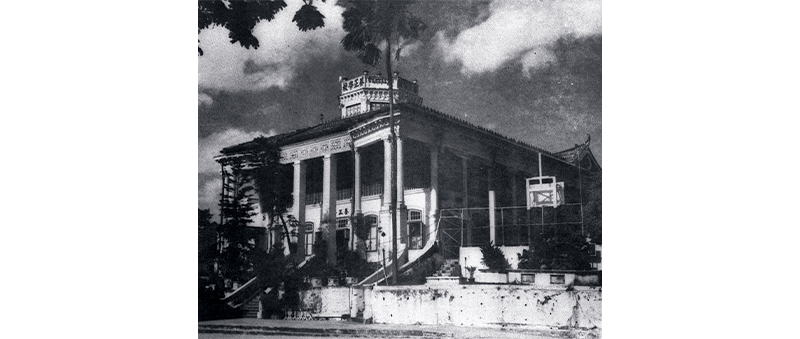
Grandfather’s sister Wong Bee Ho, who had adopted the alternate name of Wong Din Haan, was affected by the same zeal: she founded Wah Kiew Nui Hok in Singapore in the same year and became its headmistress.6
She was much admired as headmistress. Every morning at 8 am, she would arrive punctually at the school and leave at 4 pm in the afternoon. Although she never uttered a word during board meetings but just listened intently from the corner, she cared deeply for the school. Newspaper reports of the day praised her courage and determination.
Both Yeung Ching and Wah Kiew schools used Cantonese as the language of instruction since the founders were Cantonese. The early schools in Singapore were mainly founded by Chinese dialect groups or by clan associations and these naturally taught in their respective dialect. By 1904, the Hokkien community had set up Chong Cheng School (崇正学校), and by 1906, Tao Nan School (道南学校); both used Hokkien. Also in 1906, the Teochew community established Tuan Mong School (端蒙学堂), which taught in Teochew. But the rise of the Republic of China in 1911 brought a new sense of pride and national consciousness to Chinese communities overseas, leading to a common spoken language: Mandarin. Schools in Singapore also began transitioning from teaching in dialect to using Mandarin.
After 13 years, Wah Kiew Nui Hok ceased operations in 1918 – the same year that Wong Ah Fook passed away.7 This suggests that he might have been the main financial benefactor of the school. However, the school probably also faced resistance from the conservative Chinese society, which was not yet ready for the education of females. The traditional view held by many then was that girls need not be educated as their primary roles in life were to be a good daughter, wife and mother.
However, Wong Din Haan’s school was a pioneer in female education in that it inspired the establishment of five more Chinese girls’ schools in Singapore during its lifespan.8 Of these five schools, Nam Wah Nui Hok (南华女学) founded in 1917 has continued to the present day as Nan Hua High School (南华中学), a premier school for boys and girls.9
This was probably her most important legacy to Singapore as she recognised the importance of educating women for their own personal development and advancement in society. She was the first woman who had the courage and the nerve to leave the comfortable seclusion of home to push for the education of women in the face of conservative opinion.
Advocate for Women’s Rights
My grandaunt must have been bitterly disappointed when the school had to close but she continued to be socially active in community affairs. When the Chinese Ladies Association (now known as Chinese Women’s Association Singapore) was established in 1915, she was a founding member along with her younger sister Wong Bee Soo and the wives of her two younger brothers, Mrs Wong Siew Qui (née Ng Yung Chee) and Mrs Wong Siew Yuen (née Mark Shou Young).10
Ng Yung Chee was the daughter of Ng Chit Mui, the collector of tax revenue in Macau and a supporter of Dr Sun Yat-sen. Ng was a man of liberal views who allowed his daughters’ feet to remain unbound and took the trouble to educate them in both English and Chinese. Mark Shou Young was the daughter of a prominent industrialist and grew up in Japan, so she was proficient in three languages, Cantonese, English and Japanese.
The first president of the association was Mrs Lee Choon Guan (née Tan Teck Neo), daughter-in-law of prominent Peranakan businessman Lee Cheng Yan, while the other founding members included Mrs Lim Boon Keng (née Grace Yin Pek Ha) and Dr Lee Choo Neo, Singapore’s first woman doctor. At a time when women were confined to the home, the association contributed significantly to women’s development. Its activities enabled them to meet socially outside, make friends across communities, widen their horizons beyond that of their own community, and learn new skills such as making Western pastry and learning Western music.
Such activities might seem very trivial today, but they represented the first foray outside the home for Chinese women and their first exposure to the outside world. The early members of the association can be said to represent the emerging Singapore women who used their energies and good influence to improve the position of women as well as work for the public good.
When the Singapore chapter of the international martial arts organisation, Chin Woo Athletic Association, was formed in 1924, my grandaunt’s younger brother Wong Siew Qui became the vice-chairman. She and other members of her family were appointed as committee members, including younger brother Wong Siew Yuen and her two sisters-in-law.11 This is something of a surprise as none of them were particularly athletic or had displayed interest in martial arts. However, the activities of Chin Woo opened up more opportunities for women to be socially active and to participate in martial arts and other cultural activities.
Business and Religion
It was also around the 1920s that Wong Din Haan ventured into business. She started out with rubber planting and then turned to tin mining. She owned and managed Mei Yuan Company, a tin mining company in which she was said to have invested a substantial amount of money. She was no armchair investor and made a trip to Ipoh, accompanied by her assistant He Wen Lan, to personally inspect mining pools, tin dredges and palong (a wooden structure for sorting tin ore) and to view mining operations – all this while immaculately dressed in her cheongsam and her chignon still in place.
Author Zhao Guan Hai (招观海) described her thus:
Mr. He is her assistant in mining business. She has been called ‘The strong woman in the Nanyang’ (南洋之女丈夫). She was previously doing business in rubber planting but was not very successful. And then she switched to tin mining with great effort and dignity, proving herself as a leading woman of her kind. I heard that in Perak, there are only two women engaged in tin mining business, one is Madam Wong, and the other is a Hakka woman.12
By that time, my grandaunt had become deeply religious. When the Venerable Taixu (太虚法师) first came to Singapore in 1926 to promote the Buddhist faith, he was able to garner the support of local devotees, who founded the Singapore Chinese Buddhist Association (新加坡中华佛教会) in 1927. One of the founders was my grandaunt, who devoted much energy to the affairs of the association.13 She helped to set up its medical section in 1937, possibly because her son Dr Kwan Ying Hung had by then graduated from his medical studies. In 1940, she was appointed president of the association, which is around the time that she appeared to have adopted the name Wong Fook Mei (黄福美) for her religious activities.14
Fundraising Efforts
My grandaunt was also a member of the first committee of the Women’s Wing of the Chinese Chamber of Commerce; her sister-in-law Mrs Wong Siew Qui being the chairman. The Chinese Chamber of Commerce (now Singapore Chinese Chamber of Commerce and Industry), formed in 1906, was involved in various fundraising and relief efforts, both in Singapore and in China. In 1931, when the Yangtze River overflowed its bank and devastated some 180,000 sq km (an area that is over half the size of Malaysia), resulting in millions of people made homeless and lives lost, the Women’s Wing set up 12 committees to help raise funds.15
When the Second Sino-Japanese War (1937–45) broke out in China, Japanese aggression aroused much anger from the overseas Chinese communities. The Chinese Chamber of Commerce took the lead in raising funds and set up the China Relief Fund Committee in 1937 (with prominent businessman and philanthropist Tan Kah Kee as president). My father Wong Peng Shing (黄秉盛), who was a member of the Chinese Chamber of Commerce, was very much involved in fundraising and I still vividly remember the anger and anxiety he felt and how hard he worked to raise funds to alleviate the suffering of refugees.
The Nanyang Siang Pau newspaper (南洋商报) reported that the refugee relief effort was led by two elderly women, 69-year-old Mrs Leong Yuen Ho and 63-year-old Wong Din Haan. The journalist described the latter as a progressive thinker who promoted education for girls. Despite the fact that she came from a wealthy family and could have led a life of ease and leisure, she had founded a school for girls and was now active in raising funds for refugee relief. Although she seemed frail and did not speak much, she worked with strength and determination. The journalist added that all over Nanyang, everyone knew of the name “Wong Din Haan” and she was known as “The number one good person in Nanyang”.16
Fundraising took various forms. In September 1937, the Singapore Chinese Women’s Relief Fund was established at the initiative of Mrs Kao Ling-pai, wife of the Chinese Consul-General to Singapore, who became chairman of the fund. Apart from raising funds, it also provided supplies of bandages, medicine, clothing and other necessities to the war-torn areas of China17 as well as started a Refugee Children Shop (难童商店) in Singapore.
Fundraising took on new meaning when my grandaunt became president of the Chinese Ladies Association in 1939.18 Her name appeared in the headlines whenever Chinese newspapers reported on local fundraising activities. One of its activities was to run a food stall at the Great World amusement park every Saturday night. Members took turns to cook, and their names and the menus were published in the Chinese newspapers. Delicious offerings at the stall included porridge, noodles, soup, pies and even laksa.
When Women’s Day was celebrated in March 1940, nearly 1,000 women and schoolgirls gathered at Great World, where their performances, together with the sale of refreshments, raised $10,000 for the China Relief Fund.19 My grandaunt made a rousing speech as chairman of the event. War relief work was regarded as a patriotic duty in which the participation of women was welcomed. Fundraising created opportunities for women to exercise their organisational talents and abilities, and assert their qualities of leadership.
After Singapore surrendered on 15 February 1942, the Japanese military launched Operation Sook Ching “to cleanse” or purge anti-Japanese elements from the Chinese community. In particular, the Japanese looked for people involved in the China Relief Fund, members of the Chinese Chamber of Commerce, and Chinese school teachers and pupils. Between 21 February and 4 March 1942, thousands of Chinese men were summoned to report at mass screening centres and those suspected of being anti-Japanese were never seen again.
My grandaunt was one of those arrested by the Japanese. I wonder what the Japanese officers thought when this tiny old lady appeared before them. She was then 67 years old. We do not know how long she was detained for or what she was subjected to during incarceration. It must have been a traumatic experience because she died in 1942, after she was released.
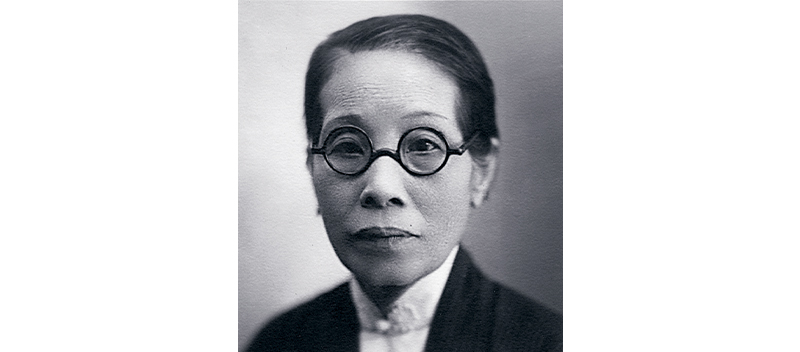
Leaving a Legacy
I remember my grandfather’s sister Saam Koo Por as a small woman who spoke very little at family gatherings. It has been an amazing journey finding out that she had accomplished so much in her life. Growing up in the 19th century when girls were generally seen and not heard, she was one of the few women who had the guts and gumption to challenge convention by venturing out and making a place for herself in the world. By founding a school for girls, she not only paved the way for female education but was also a trailblazer in showing how educated women could play a progressive role in society.
Grandaunt Wong Din Haan was a remarkable woman. Although she is remembered as a pioneer educator, she was much more than that. She came into prominence when the Chinese in Singapore needed direction in a time of stress arising from dire situations in China. While my grandaunt’s fundraising efforts were laudable, what is far more important is that the causes she dedicated herself to revealed her vision and leadership and gained her recognition as a respected leader of the Chinese community in Singapore.
However, my grandaunt had been so modest and retiring that even her grandchildren do not know of her achievements. This essay honours her memory by bringing her out of the shadows of the past. I hope that her legacy of dedication, courage and determination will live on and serve as an inspiration for future generations to come.
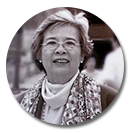 After retiring as founding Librarian and Research Fellow at the ISEAS-Yusof Institute, Patricia Lim Pui Huen finds pleasure in exploring Singapore’s history and discovering the roots of her family’s past. Her publications include a biography of her great grandfather, Wong Ah Fook: Immigrant, Builder and Entrepreneur (Times Editions, 2003). In 2020, she published a volume of short stories One-Legged Football and Other Stories (Areca Books), which highlights the challenges faced by people with disabilities.
After retiring as founding Librarian and Research Fellow at the ISEAS-Yusof Institute, Patricia Lim Pui Huen finds pleasure in exploring Singapore’s history and discovering the roots of her family’s past. Her publications include a biography of her great grandfather, Wong Ah Fook: Immigrant, Builder and Entrepreneur (Times Editions, 2003). In 2020, she published a volume of short stories One-Legged Football and Other Stories (Areca Books), which highlights the challenges faced by people with disabilities.
NOTES
-
郑良树 [Zheng Liang Shu], “新马华社早期的女子教育” [“Early Education for Girls in the New Malayan Society”], 马来西亚华人研究学刊 Journal of Malaysian Chinese Studies, no. 1 (1997), 49. (From National Library, Singapore, Call no. RU 959.5004951 JMCS) ↩
-
Hailing from Guangdong province, China, Wong Ah Fook came to Singapore in 1854 as a carpenter. He first established himself in the building business before venturing into agriculture, revenue farming and banking. He was responsible for the construction of a number of Johor’s heritage buildings, including the Istana Besar, the royal palace of the Sultan of Johor. Jalan Wong Ah Fook in downtown Johor Bahru is named after him. ↩
-
Zheng, “新马华社早期的女子教育” [“Early Education for Girls in the New Malayan Society”], 48. ↩
-
The Boxers, (so named because they practised Chinese martial arts, then known as Chinese boxing) were members of a secret society called the Yihequan (Society of Righteous and Harmonious Fists) that aimed to purge China of foreign influences and evict foreigners from China. In June 1900, Empress Dowager Cixi declared war on all foreign nations with diplomatic ties in China. An international force, the Eight-Nation Alliance, was formed comprising America, Austria-Hungary, Britain, France, Germany, Italy, Japan and Russia to quell the rebellion. Hostilities ended with the signing of the Boxer Protocol on 7 September 1901. ↩
-
Immanuel C.Y. Hsü, The Rise of Modern China, 3rd ed (Hong Kong: Oxford University Press, 1989), 410–11. NLB has the 6th edition. See Immanuel C.Y. Hsü, The Rise of Modern China , 6th ed (New York: Oxford University Press, 2000). (Call no. R 951.03 HSU) ↩
-
Zheng, “新马华社早期的女子教育” [“Early Education for Girls in the new Malayan Society”], 48. ↩
-
“捐欵千元助賑之黃典嫻及梁鄧氏訪問” [“Contributing a Thousand Dollars for Disaster Relief, An Interview with Wong Din Haan and Madam Leong Tang”], 南洋商报 [Nanyang Siang Pau], 31 August 1937, 7. (From NewspaperSG) ↩
-
Zheng, “新马华社早期的女子教育” [“Early Education for Girls in the new Malayan Society”], 52. ↩
-
Nan Hua High School, “History,” accessed 15 November 2021, https://nanhuahigh.moe.edu.sg/our-heritage/history. ↩
-
Lindsay Davis, ed., Chinese Women’s Association: 100 Fabulous Years (Singapore: Editions Didier Millet, [2015]), 20–21. (From National Library, Singapore, Call no. RSING 305.488951095957 CHI) ↩
-
“本坡精武體育會之新職員” [“New Committee Members of the Singapore Chin Woo Athletic Association”], 南洋商报 [Nanyang Siang Pau] 14 April 1925, 3. (From NewspaperSG) ↩
-
招观海 [Zhao Guan Hai], 天南游记 [Travel Beneath the Southern Skies] (n.p.: n.p.,1933), 68–70. (Not available in NLB holdings) ↩
-
柯木林 [Ke Mulin; Kua Bak Lim], ed., 新加坡华人通史 [A General History of the Chinese in Singapore]. (Singapore: Singapore Federation of Chinese Clan Associations, 2015), 341. (From National Library, Singapore, Call no. Chinese RSING 959.57004951 GEN-[HI) ↩
-
“佛教訪問…” [“A Buddhist Interview…”], 南洋商报 [Nanyang Siang Pau], 22 April 1940, 7. (From NewspaperSG) ↩
-
“總商會籌賑會婦女部召開第一次會議議决全部分爲十二組並選出各組正副主任” [“Women’s Wing of the Chinese Chamber of Commerce, at its First Meeting, Splits into 12 Committees and Appoints their Chairmen and Vice-Chairmen”], 南洋商报 [Nanyang Siang Pau], 22 February 1932, 6. (From NewspaperSG) ↩
-
“捐欵千元助賑之黃典嫻及梁鄧氏訪問記” [“Contributing a Thousand Dollars for Disaster Relief, An Interview with Wong Din Haan and Madam Leong Tang”]. ↩
-
“Help for Victims in War Torn China,” Straits Times, 12 September 1937, 4. (From NewspaperSG) ↩
-
“星華婦女會昨選出各部職員黃典嫻被舉為正會長” [“Singapore Chinese Ladies Association Elected its Office-bearers Yesterday, Wong Din Haan Elected President”], 南洋商报 [Nanyang Siang Pau], 11 April 1939, 8. (From NewspaperSG) ↩
-
“徐悲鴻籌賑畫展在商會繼續舉行今日起至二十六日止婦女會派員担任招待” [“Xu Beihong’s Charity Painting Exhibition for China Relief Fund Held at the Chinese Chamber of Commerce, Will Begin Today until March 26”], 南洋商报 [Nanyang Siang Pau], 18 March 1939, 7; “Chinese Women’s Day Celebration,” Singapore Free Press and Mercantile Advertiser, 9 March 1940, 5. (From NewspaperSG) ↩

